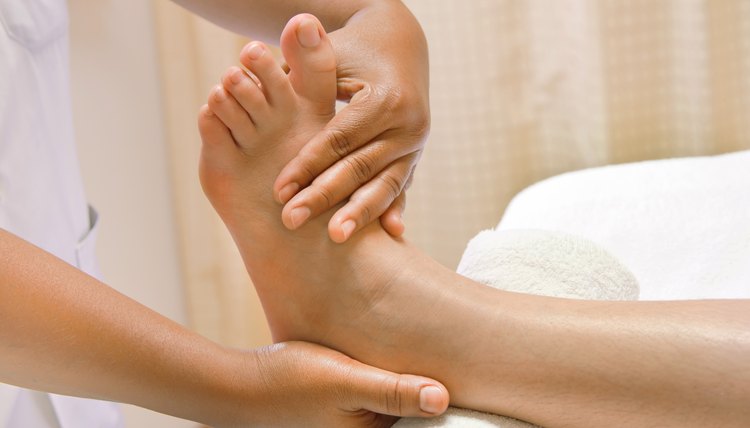Rehabilitation Exercises for Lisfranc Fracture Dislocation

Your Lisfranc joint, also known as the tarsometatarsal joint, lies within your midfoot area as part of a bone cluster that makes up the arch along the top part of your foot. The joint plays a role in transferring force between your midfoot and forefoot area. Common symptoms of a fracture or dislocation include swelling and inability to bear weight. Rehabilitation exercises for a Lisfranc fracture dislocation help restore foot flexibility and increase strength. Not all exercises may be for you, so consult with your doctor first.
Towel Scrunchers
Start viewing towels as versatile exercise tools as part of your rehabilitation exercises for a Lisfranc fracture dislocation. Strengthen your foot muscles while also improving your toe flexibility by doing some towel scrunching exercises. Sit upright in a firm chair and spread a towel on the floor in front of your chair. Place your injured foot onto the towel. Use your toes to start scrunching up the towel underneath your foot, bringing it back toward the chair. Keep your heel on the floor at all times. Do this exercise for two minutes. Gently lift your foot and straighten the towel. Relax 10 seconds. Repeat this exercise five times.
Inward Scrunchers
Another way to utilize a towel as part of your rehabilitation exercises for a Lisfranc fracture dislocation is by doing side inversion maneuvers. Sit upright in a firm chair and spread out a towel on the floor. Place your injured foot onto the towel end closest to your body. Slowly lift your foot, but not your heel, and move the towel sideways toward your body. If done correctly, your ankle will be doing an inward rotation. Make 10 sideways maneuvers. Spread the towel straight and relax 10 seconds. Repeat the exercise five times. Use newspaper if a towel is not available.
Gentle Bending
Working on your ankle strength and flexibility plays an important role during rehabilitation exercises for a Lisfranc fracture dislocation. Accomplish this goal by doing some ankle bending maneuvers while either immersed in warm water or sitting upright in a firm chair on land. Gently lift your injured leg in front of your body. Slowly bend your ankle so your toes face the floor, according to the University of Washington Orthopaedics and Sports Medicine Department. Hold position five seconds. Slowly return to original position. Relax 10 seconds. Gently and slowly bend ankle so toes point upward. Hold position five seconds. Return to original position. Relax 10 seconds. Repeat exercise 10 times.
Toe Stretchers
Some individuals may find exercising on land too painful due to physical limitations or excessive pain. Doing your rehabilitation exercises for a Lisfranc fracture dislocation in water will help increase mobility while relaxing muscles and lowering pain levels. Do some toe flexions by first getting in some warm waist- or chest-deep water. Gently lift your injured foot to a comfortable level. Slowly move your toes toward the pool's bottom. Hold position five seconds. Return toes to original position. Relax 10 seconds. Slowly lift toes toward ceiling. Hold position five seconds. Repeat exercise 10 times.
References
Resources
Writer Bio
Crystal Welch has a 30-year writing history. Her more than 2,000 published works have been included in the health and fitness-related Wellness Directory, Earthdance Press and Higher Source. She is an award-winning writer who teaches whole foods cooking and has written a cookbook series. She operates an HON-code-certified health-related blog with more than 95,000 readers. Welch has a B.B.A. from Eastern Michigan University.
